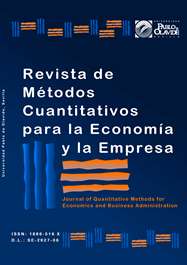Calculation of a multicriteria indicator for the management of human and technological resources in a hemodialysis service
DOI:
https://doi.org/10.46661/revmetodoscuanteconempresa.4195Keywords:
Management Indicators, Key Performance Indicators (KPIs), Hospital Units, Multicriteria Decision Analysis, Modified Reference Ideal MethodAbstract
The aim of this presentation is to develop a composite indicator, which should be consistent and reliable, to evaluate the physiological conditions of a group of patients on dialysis therapy. The composite indicators are developed based on key performance indicators. They have the advantage of being able to be interpreted quickly and give to the decision makers an orientation on the procedures to be followed.
The purpose is to provide a management indicator to optimize the activities of this hospital unit, and in this way, to provide patients maximum care.
The composite indicator was built with the clinical laboratories, which are performed on patients on dialysis treatment.
The central idea of the study is to make a ranking of patients based on the criteria that support the physiological conditions of each one of them. The study was carried out in one of the major hospitals in the city of Córdoba, Argentina.
To solve the problem, we applied the multicriteria decision analysis, specifically, the Reference Ideal Method. Modifications to the traditional technique have been proposed to make it possible to work with several ideal reference intervals in the same criterion.
The referral to experts in order to define the criteria and the relative weights has been performed by application of the Delphi Method.
Downloads
References
Burns, A.F., & Mitchell, W.C. (1946). Measuring business cycles. Studies in business cycles. USA: National Bureau of Economic Research. https://www.jstor.org/stable/1826221
Cables, E., Lamata, M. T., & Verdegay, J. L. (2016). RIM reference ideal method in multicrtiteria decision making. Information Science 337, 1-10. https://www.sciencedirect.com/science/article/abs/pii/S0020025515009007
Domínguez, M., Blancas, F.J., Guerrero, F.M., & González, M. (2011). Una revisión crítica para la construcción de indicadores sintéticos. Métodos Cuantitativos para la Economía y la Empresa 11, 41-70. https://www.upo.es/revistas/index.php/RevMetCuant/article/view/2094
González, D. (11 de octubre de 2018). www.neuroeconomics.com/analisis-de-decision-multicriterio-mcda/. Recuperado el 15 de abril de 2020, de www.neuroeconomics.com/analisis-de-decision-multicriterio-mcda/
Karel, W., Brauers, W., & Zavadskas, E. (2006). The MOORA method and its applications to privatization in a transition economic. Control and Cybernetics 35, 2. https://citeseerx.ist.psu.edu/viewdoc/download?doi=10.1.1.379.8910&rep=rep1&type=pdf
Martín, J., Puerto, M., Caballero, R., & Luque, M. (January de 2005). Financiación de Hospitales y Asignación de Recursos mediante Técnicas Multicriterio Interactivas. Recuperado el 25 de abril de 2020, de https://www.researchgate.net/publication/229023093_Financiacion_de_hospitales_y_asignacion_de_recursos_mediante_tecnicas_multicriterio_interactivas: http://www.uib.es/congres/ecopub/papers/sanidad/Martin-Puerto-Caballero-Luque.pdf.
Munda, G. (2004). Métodos y Procesos Multicriterio para la Evaluación Social de las Políticas Públicas. Iberoamericana de Economía Ecológica, 1, 31-45. https://raco.cat/index.php/Revibec/article/view/38279 [Consulta: 24-08-2021
Nardo, M., Saisana, M., Saltelli, A., Tarantla, S., Hoffman, A., & Giovannnini, E. (2008). Handbook on constructing composite indicators: methodology user guide. Paris: OECD European Union. https://unstats.un.org/unsd/EconStatKB/KnowledgebaseArticle10366.aspx
Opricovic, S., & Hshiung, G. (2004). Compromise Solution by MCDM methods: a comparative analysis of Vikor and Topsis. European Journal of Orational Research, 156, 445-455. https://www.sciencedirect.com/science/article/abs/pii/S0377221703000201
Roy, B. (1985). Méthodology multicritere d´aide a la decision. Paris: Económica.
Schuschny, A., & Soto, H. (2009). Guía Metodológica. Diseño de indicadores compuestos de desarrollo sostenible. Santiago de Chile: Comisión Economica para América Latina y el Caribe (CEPAL). https://www.bivica.org/file/view/id/2485
Yonn, K., & Hwang, C. L. (1995). Multiple Attribute Decision Making: An Introduction. California, USA: Sage.
Zozaya, N., Oliva, J., Hidalgo, Á., & García, A. (2018). El Análisis de Decisión Multi-Criterio en el ámbito sanitario: utilidad y limitaciones para la toma de decisiones. Madrid - España: Fundación Weber. https://weber.org.es/publicacion/el-analisis-de-decision-multi-criterio-en-el-ambito-sanitario-utilidad-y-limitaciones-en-la-toma-de-decisiones/
Downloads
Published
How to Cite
Issue
Section
License

This work is licensed under a Creative Commons Attribution-ShareAlike 4.0 International License.
Submission of manuscripts implies that the work described has not been published before (except in the form of an abstract or as part of thesis), that it is not under consideration for publication elsewhere and that, in case of acceptance, the authors agree to automatic transfer of the copyright to the Journal for its publication and dissemination. Authors retain the authors' right to use and share the article according to a personal or instutional use or scholarly sharing purposes; in addition, they retain patent, trademark and other intellectual property rights (including research data).
All the articles are published in the Journal under the Creative Commons license CC-BY-SA (Attribution-ShareAlike). It is allowed a commercial use of the work (always including the author attribution) and other derivative works, which must be released under the same license as the original work.
Up to Volume 21, this Journal has been licensing the articles under the Creative Commons license CC-BY-SA 3.0 ES. Starting from Volume 22, the Creative Commons license CC-BY-SA 4.0 is used.










